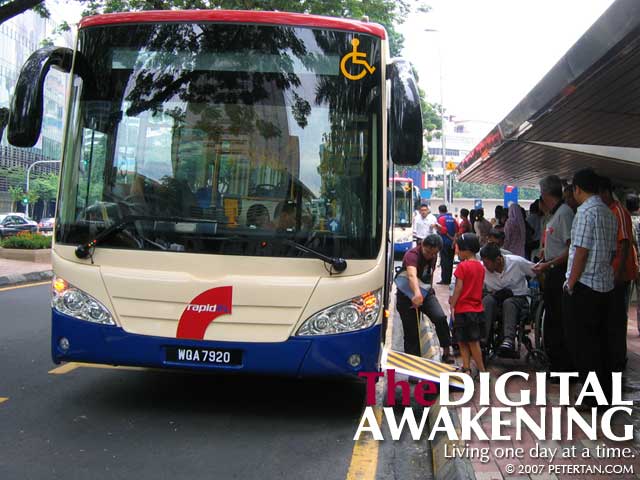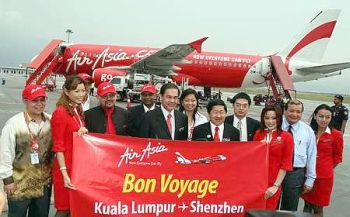Nation
Tuesday July 17, 2007Order to Malaysia Airports and AirAsia: Ease movement of the disabled
Launched: Chan (centre), AirAsia chairman Datuk Pahamin Rejab (fourth from left), Fernandes (fifth from left), Deputy Tourism Minister Datuk Donald Lim Siang Chai (fifth from right), counselor Gu Jing Qi from the Chinese embassy (fourth from right) and Malaysia Airports senior general manager (operations) Datuk Azmi Murad (second from right) at the launch of the inaugural AirAsia flight from Kuala Lumpur to Shenzhen, China in Sepang.
PUTRAJAYA: Malaysia Airports Berhad and AirAsia have been ordered to thrash out their problems to ensure the disabled community could use the airline with ease.“I had a dialogue with representatives of the disabled community and fully agree that some kind of facilities should be provided to ease their movement,” said Transport Minister Datuk Seri Chan Kong Choy.
“I have given instructions that something has to be done; I want to see solutions and want both parties to work things out,” he said, adding that upgrading of facilities at the Low-Cost Carrier Terminal (LCCT) had taken place gradually, such as the construction of covered walkways.
He was commenting on the disabled community’s complaints against AirAsia and the LCCT after launching the inaugural AirAsia flight from Kuala Lumpur to Shenzhen, China, in Sepang yesterday.
The main complaint by the Barrier-Free Environment and Accessible Transport Group was AirAsia’s refusal to take passengers who were completely immobile, suggesting that the carrier review its policies to provide facilities that were non-discriminatory.
On passengers being stranded at the Kuala Lumpur International Airport (KLIA) due to overbooking of flights by Malaysia Airlines (MAS) last Sunday, Chan said he was waiting for a full explanation from MAS.
AirAsia group CEO Datuk Tony Fernandes, who was present at the launch, explained that the carrier accepted partially paralysed passengers but had no facilities for totally paralysed passengers.
Stating that they would have to change the whole configuration of their planes to accommodate totally paralysed passengers, Fernandes added that it was not feasible.
He said that for such passengers, the aisles and the toilets would have to be bigger.
“For wheelchair-bound passengers, we do not charge them for the wheelchair but take them to the plane and physically carry them into the plane,” he said.
Tag: Chan Kong Choy
NST – July 17, 2007: Minister wants AirAsia to settle wheelchair issue
2007/07/17
Minister wants AirAsia to settle wheelchair issueSEPANG: Settle the problem fast.
This was Transport Minister Datuk Seri Chan Kong Choy’s directive to AirAsia and Malaysia Airports Holding Berhad (MAHB) over complaints from wheelchair-bound passengers that the low-cost carrier had refused to accommodate them on its flights.An unhappy Chan said he wanted solutions to the problem — quickly.
The government, he said, felt that all assistance to help disabled air travellers must be extended.
He was met at the launch of AirAsia’s Kuala Lumpur-Shenzhen flight at the Low-Cost Carrier Terminal here.
On Sunday, members of the Barrier-free Environment and Accessible Transport Group staged a peaceful protest at the terminal over the airline’s refusal to accept passengers requiring special assistance.The group called on the airline to provide facilities for passengers who were immobile and those with limited mobility and for MAHB to ensure all new and old airports were equipped with facilities for the disabled.
AirAsia chief executive Datuk Tony Fernandes, meanwhile, denied that the airline had turned away wheelchair-bound passengers.
He said ground staff would take such passengers to the aircraft and physically carry them onboard.
“We do not even charge for this service and there is certainly no discrimination against them. All they have to do is to inform us in advance of the assistance they need.”
However, he said the airline could not cater to those with total immobility as it did not have the facilities available on full service airlines like suitable toilets, wider aisles and detachable seats.
He said if changes were to be made to cater to this group, it would mean a total reconfiguration of AirAsia planes.
Fernandes said as a budget airline, it had its limitations unlike full service carriers.
“Our position is comparable to hospitals that have various areas of specialisations like those treating heart diseases and bone problems. It is the same for AirAsia. We cannot cater to everyone… we have to be real on what we can or cannot do.”
Fernandes said AirAsia had discussed with MAHB the possibility of providing “ambulifts” to help ferry disabled passengers onboard.
But he said the plan would only be feasible if the airport operator was willing to reduce charges at the terminal.
Fernandes said another possible solution was to hire more staff to handle disabled passengers but the additional costs involved might lead to costlier fares.
Fernandes also announced that passengers aged above 65 no longer needed to pay additional fees to be given priority to board AirAsia planes.
On another matter, Chan said Malaysia Airlines had been directed to submit a full report immediately on the hundreds of passengers who were stranded and delayed at the Kuala Lumpur International Airport on Sunday.
Disabled Persons’ Endless Problems With Public Transport

Photo by Wuan.
During RapidKL’s accessible buses pre-launch briefing for the media, Chief Operating Office Mohd. Ali. Mohd. Nor announced that 100 accessible buses will be put into service in the Klang Valley on June 1. These buses will only serve the trunk lines and city shuttles but not the local shuttles that serve housing estates. This defeats the purpose of putting these buses in service as wheelchair users will be unable to get to the trunk line hubs from their homes. Mohd. Ali should realise that the last mile connectivity is as important as the trunk lines and city shuttles.
Another major area of concern is the mismatch of height between the bus stops and the buses. The difference can be as much as 9 inches, rendering the gradient of the ramp too steep even with assisted boarding for wheelchair users. This is prevalent in most of the bus stops that the Barrier-Free Environment and Accessible Transport Group (BEAT) and officers from RapidKL discovered during a preview of the buses.
Local authorities are responsible for infrastructure such as bus stops and walkways. They must work hand in hand with RapidKL to ensure that this problem is resolved soonest possible. Additionally, walkways must be made accessible as required by the Uniform Building By-Law 34A (UBBL 34A). This by-law had been gazetted by the various state governments in the mid-90s. Unfotunately, the requirement of this by-law is ignored most of the time, leading to the pathetic and dangerous state of the walkways that exist now.
Disabled persons cannot and should not be expected to advocate to so many different ministries on only a single issue like public transport. For example, we have met with Deputy Minister of Finance Datuk Dr. Ng Yen Yen and Minister of Transport Dato’ Seri Chan Kong Choy. RapidKL is owned by Syarikat Prasarana Negara Berhad which is the holding company under the Ministry of Finance Incorporated. At the same time RapidKL is also under the purview of the Ministry of Transport. Additionally, due to the bus stops being inaccessible, we have to advocate to the various local authorities which is under the Ministry of Housing and Local Government and the Menteri Besar. And that is only one thin slice of the issues that affects disabled persons.
Dato’ Seri Chan had the foresight to establish a high level public transport advisory committee chaired by the Deputy Secretary-General of the ministry to look into the grouses of disabled persons with regards to public transport. According the him, it was set up as a single platform for disabled persons to voice out their problems without the need to run around to meet the different transport operators individually. For this, Dato’ Seri Chan gets two thumbs up.
However, it is time the government see the bigger picture of the problems faced by disabled persons. It is neither feasible nor cost effective to address issues on a piecemeal basis. The most apparent example is the mismatch of height between RapidKL’s accessible buses and bus stops. Solving one problem creates a host of other problems. It is a never ending cycle. By the way things are being done now disabled persons will still be facing barriers come the next fifty years.
Several leaders in the disability movement in Malaysia have suggested that a division be set up within the highest level of the government, namely the Office of the Prime Minister, to oversee and manage all issues related to disabled persons. With that, we do not have to scamper from one ministry to another to have our voices heard and our issues resolved. As far as we can see, this is the most effective solution. Apa macam Pak Lah?

